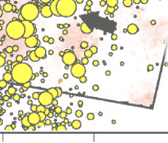 |
 |
 |
 |
 |
 |
 |
 |
Taiwan has resulted from on-going collision between the Luzon volcanic arc, the continental margin of south China, 5 to 7 Myr ago, and intervening continental fragments. In the north, the island is submitted to horizontal extension as the orogen transfers to the hanging wall of the Ryukyu subduction system. To the south, subduction is still going on along the Manilla trench. Taiwan is an exceptional active orogen, due to its extremely rapid rates of deformation and high erosion rates. A dense array of survey-mode and continuous GPS stations monitor tectonic deformation across the entire island and landforms and stratigraphy provide an exceptional source of information on ongoing lithospheric deformation. In addition, neotectonic deformation was illuminated by the Mw 7.6 Chichi earthquake of 1999, which ruptured the Chelungpu thrust fault under the Western Foothills.
Taiwan is therefore an exceptional area to investigate mountain building processes over time scales ranging from the seconds of an earthquake to millions of years of an orogeny. It is also a ultimate place to investigate both the transition from subduction to collision and from collision to collapse.Among the key scientific questions to be addressed :
The TO effort will first focus on the determination of the kinematics of the deformation across the range and how it varies along strike in relation to the different stage of development of the collision, or different stage in the seismic cycle. We will also work out the thermal structure taking advantage of recent technical advances (Carbonaceaous Matter Graphitisation as a quantitative tool to estimate peak metamorphic temperatures). Indeed the thermal structure is probably controlling the mechanics of the deformation on the long term as well and seismic behavior. Also we would need better constraints on the geometry of the faults at depth. By combining with geodetic information on crustal deformation during the interseismic phase, or related to Chichi co-seismic and post seismic deformation, we should be able to develop a well constrained physical model of the seismic cycle.
Funding provided in part by the National Science
Foundation |
|
